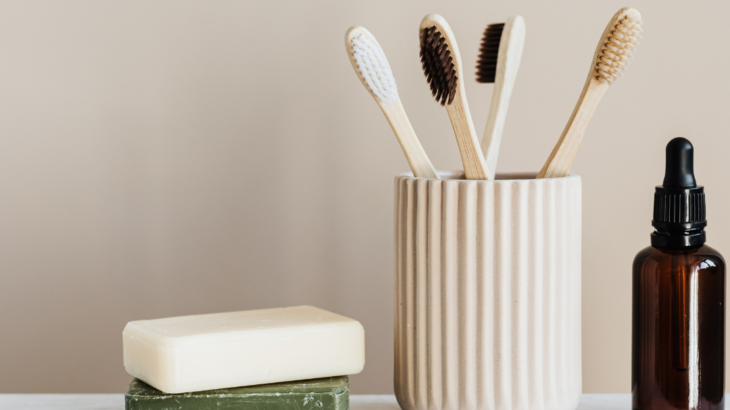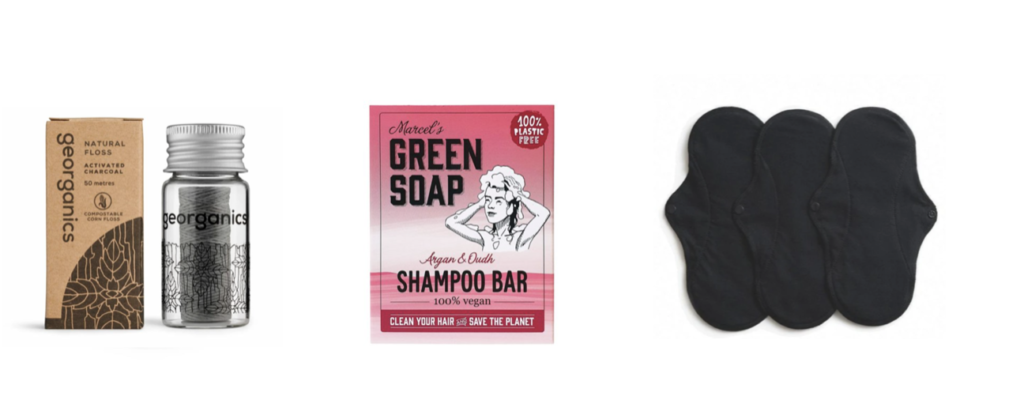Self-care the Sustainable Way

As a young teen, I was obsessed with buying new and cheap self-care products. Of course, the market never disappointed, with new products rolling in almost daily. Being older, and (hopefully) wiser now, I understand how detrimental the environmental impacts of fast-moving consumer goods can be.
Most of the products we buy for self-care are packaged in plastic, produced in faraway lands, and are quickly thrown away without a second thought. Just take a look around in your bathroom, around your sink, and in the shower. How many products are made out of plastic? Shampoo and conditioner bottles, face wash, soap, toothbrushes, toothpaste, deodorant, and even floss! The packaging of some of these products may get recycled, but the reality is that only about 29% of the plastic produced in the Netherlands is recycled [1]. But don’t worry! There are many plastic-free alternatives for your self-care, and you do not have to go all-out and follow a zero-waste lifestyle if that does not work for you. I tried, and whilst I learnt a lot from it, it was a little too much effort for me at this point in my life (another blog post about this will follow). So for a more convenient alternative, here are a couple of simple changes you can make to be a little bit more sustainable:
- Once your plastic toothbrush needs replacing, buy a toothbrush with a wooden handle instead. The wooden handles can be thrown away in the compost. However, It’s important to note that most wooden toothbrushes come with nylon bristles that first need to be removed before you can throw the toothbrush away in the compost bin. The nylon bristles need to be thrown away with your general waste. You can use pliers to pull the bristles out, or what I sometimes do, is snap off the brush head and just throw that away with the general waste. If you use an electric toothbrush, recyclable toothbrush heads also exist!
- Replace your floss with compostable floss. An example is the Georganics Natural Charcoal Floss, which is completely compostable. The floss itself comes in a glass container, which can be refilled.
- Get mouthwash and toothpaste tablets. Many of these are available in several stores, and you can choose between ones with or without fluoride as well.
- Opt for soap, shampoo and conditioner bars the next time you run out. Many of these “bars” exist these days, and a lot of them come in paper packaging. You end up saving on quite a lot of plastic bottles this way. Watch out for greenwashing from many brands though, as some larger brands have come up with, for example, shampoo bars that are still packaged in plastic containers, which just defeats the purpose! These alternative products don’t have to be expensive either. I personally love the shampoo bars by Marcel’s Green Soap (100% plastic-free). In the Gieterij (package-free store) in Wageningen you can also buy a general soap bar (around 1 euro) that you can use for almost everything. No need to buy fancy soap bars then!
- For those who menstruate, you can replace single-use pads with reusable (washable) pads, or period underwear. Instead of tampons, period cups are also available.
- Do you use makeup? Instead of removing it with single-use cotton pads, try use washable ones instead. Very simple to use, and reduces a lot of waste.
- There are many deodorants available now that are not packaged in plastic. I definitely suggest you try them out, although some do have baking soda in the ingredients, which might be irritating if you have sensitive skin.
- Lastly, I suggest that every household should get an organic/compost bin in their bathrooms, so that you can throw away things like your compostable floss. For those with long hair, I’m sure you’re familiar with some shedding, and that can also go into your compost.

* I’m sure that there are many more ways you could make self-care more sustainable, but hopefully I listed a couple of things you can try out. I’m sure every little bit helps 🙂
* It is important that you do not buy new products just for the sake of buying new products. Try to use what you have first, until the items really need replacing. Then, it is wise to slowly swap out your unsustainable products for more sustainable products. This way you do not end up with an overfilled house, and maybe this way the new habits will stick longer too.
By Nathalie van der Wel

